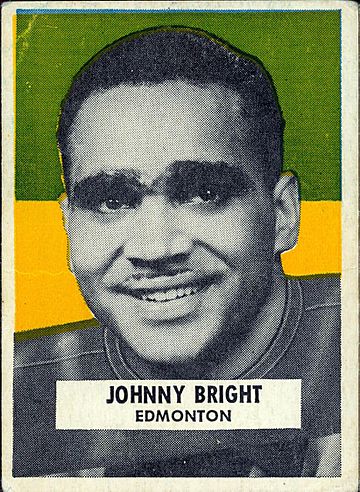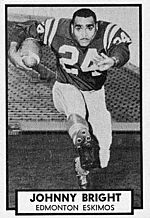Johnny Bright facts for kids
| No. 24 | |

Bright depicted in a 1959 football card
|
|
| Born: | June 11, 1930 Fort Wayne, Indiana, US |
|---|---|
| Died: | December 14, 1983 (aged 53) Edmonton, Alberta, Canada |
| Career information | |
| Position(s) | Halfback, Linebacker |
| Height | 6 ft 1 in (185 cm) |
| Weight | 217 lb (98 kg) |
| College | Drake |
| NFL draft | 1952 / Round: 1 / Pick: 5 |
| Drafted by | Philadelphia Eagles |
| Career history | |
| As player | |
| 1952* | Philadelphia Eagles |
| 1952–1954 | Calgary Stampeders |
| (1954–1964) | Edmonton Eskimos |
| Career highlights and awards | |
|
|
| CFL West All-Star | 6x (1952, 1957–1961) |
| Awards |
|
| Honours |
|
| Retired #s | Drake Bulldogs No. 43 |
| Records |
|
| Career stats | |
| Rushing yards | 10,909 |
| Rushing touchdowns | 70 |
| Rushing average | 5.5 |
| Interceptions | 7 |
|
|
John Dee Bright (born June 11, 1930 – died December 14, 1983) was an amazing American football player. He played in the Canadian Football League (CFL). Before that, he was a star in college football at Drake University. Johnny Bright is remembered in many Halls of Fame, including the Canadian Football Hall of Fame and the College Football Hall of Fame.
In 1951, he was named an All-American, meaning he was one of the best college football players in the country. He also won an award for good sportsmanship. Drake University even called him their greatest football player ever. His jersey number, 43, was retired by the school, which means no other player at Drake can wear it. In 2006, the football field at Drake Stadium was named in his honor. The CFL also voted him one of their top 50 players of all time.
Johnny Bright was involved in a famous event in 1951. An opposing player intentionally hurt him during a game. This event, known as the "Johnny Bright incident", led to important changes in football rules.
Contents
Early Life and Sports Talent
Johnny Bright was born in Fort Wayne, Indiana, on June 11, 1930. He was one of five brothers. His family lived in a working-class neighborhood.
He was a fantastic athlete in high school. He played football, basketball, and track and field. He was also a good softball pitcher and boxer. In 1945, he led his high school football team to a city championship. His basketball team also reached the state tournament Final Four twice.
College Football Journey
After high school, Bright first went to Michigan State University. But he soon transferred to Drake University in Des Moines, Iowa. There, he earned a scholarship for track and field. This allowed him to try out for the football and basketball teams. He ended up playing all three sports at Drake.
After a year of not playing (a "redshirt" year), Bright started his college football career in 1949. As a sophomore, he led the country in total offense. He rushed for 975 yards and threw for another 975 yards. The Drake Bulldogs finished that season with a good record.
In his junior year (1950), he broke an NCAA record. He rushed for 1,232 yards and passed for 1,168 yards. This gave him 2,400 total yards, a new record. His senior year in 1951 started with high hopes. He was considered a top player for the Heisman Trophy award. He was leading the nation in rushing and total offense.
The Unfair Play: Johnny Bright Incident
On October 20, 1951, Drake played against Oklahoma A&M (now Oklahoma State University). This game was special because Johnny Bright was a prominent Black athlete. He was very important to Drake's success. It was the first time such a famous Black player played against Oklahoma A&M at their home field.
During the game's first seven minutes, Bright was hit hard three times. These hits came from an Oklahoma A&M player named Wilbanks Smith. The last hit, an elbow, broke Bright's jaw. Even with a broken jaw, Bright threw a 61-yard touchdown pass. But the injury forced him to leave the game soon after. Oklahoma A&M won the game 27–14.
Newspaper photographers captured the hits in a series of photos. These pictures clearly showed that Smith hit Bright after he had already passed the ball. The hit was also far from the main play. It was known before the game that Oklahoma A&M planned to target Bright. Local newspapers even reported that Bright was a "marked man."
Because no action was taken against Smith, Drake University left the Missouri Valley Conference. Another school, Bradley University, also left to support Drake. The "Johnny Bright Incident" led to changes in NCAA football rules. These changes made illegal hits clearer and required better helmets with face guards.
Years later, Bright spoke about the incident without anger. He said, "There's no way it couldn't have been racially motivated." He also felt that his broken jaw helped make college sports better. He believed it made the NCAA fix some bad things.
After the Injury
Bright's jaw injury affected his play for the rest of his senior year. Still, he finished his college career with amazing stats. He had 5,983 total yards and scored 384 points in 25 games. In his senior year, he was responsible for 70% of Drake's yards and 70% of their points. This was despite missing parts of the last three games.
After his final season, Bright was named an All-American. He also finished fifth in the voting for the 1951 Heisman Trophy. He played in two important post-season games. In 1969, Drake University named him their greatest football player ever. His number 43 jersey is the only one retired by the school.
Professional Football Career in Canada
In 1952, the Philadelphia Eagles picked Johnny Bright first in the NFL draft. But Bright chose to play in Canada instead. He joined the Calgary Stampeders in the Western Interprovincial Football Union. This league later became part of the Canadian Football League.
Bright explained his choice: "I would have been their (the Eagles') first Black player. There were many Southern players in the NFL then. I didn't know what kind of treatment I could expect."
He started with the Calgary Stampeders in 1952 as a fullback and linebacker. He led the league in rushing with 815 yards in his first year. In 1954, he was traded to the Edmonton Eskimos. This is where he had the most success in his career.
With the Eskimos, Bright helped his team win three Grey Cup championships in a row. These wins were in 1954, 1955, and 1956. In the 1956 Grey Cup, he rushed for a record 169 yards. This helped Edmonton win 50–27. In 1957, he rushed for over 100 yards in eight straight games. He finished that season with 1,679 yards. In 1958, he rushed for an incredible 1,722 yards.
In 1959, Bright won the CFL's Most Outstanding Player Award. He was the first Black athlete to receive this honor. NFL teams tried to get him to play in the United States. But Bright had already started a teaching career in 1957. He had moved his family to Edmonton. He said, "I'd established a home and Canada had been good to me."
Bright retired in 1964. He was the CFL's all-time leading rusher at that time. He rushed for 10,909 yards in 13 seasons. He had five seasons in a row with over 1,000 rushing yards. His career average of 5.5 yards per carry is one of the highest ever. He played in 197 games in a row. His number 24 jersey was added to the Edmonton Eskimos' Wall of Honour in 1983. He was inducted into the Canadian Football Hall of Fame in 1970.
Career Statistics
| Year | Team | Games | Rush | Yards | Average | Longest | Touchdowns |
|---|---|---|---|---|---|---|---|
| 1952 | Calgary Stampeders | 13 | 144 | 815 | 5.7 | 75 | 2 |
| 1953 | Calgary Stampeders | 9 | 38 | 128 | 3.4 | 32 | 0 |
| 1954 | Calgary Stampeders | 1 | 8 | 30 | 3.8 | 14 | 0 |
| 1954 | Edmonton Eskimos | 11 | 37 | 184 | 5.0 | 12 | 0 |
| 1955 | Edmonton Eskimos | 12 | 107 | 643 | 6.0 | 34 | 2 |
| 1956 | Edmonton Eskimos | 9 | 93 | 573 | 6.2 | 22 | 4 |
| 1957 | Edmonton Eskimos | 16 | 259 | 1679 | 6.5 | 27 | 16 |
| 1958 | Edmonton Eskimos | 16 | 296 | 1722 | 5.8 | 90 | 8 |
| 1959 | Edmonton Eskimos | 16 | 231 | 1340 | 5.8 | 53 | 11 |
| 1960 | Edmonton Eskimos | 16 | 251 | 1268 | 5.1 | 28 | 14 |
| 1961 | Edmonton Eskimos | 16 | 236 | 1350 | 5.7 | 81 | 11 |
| 1962 | Edmonton Eskimos | 11 | 142 | 650 | 4.6 | 23 | 2 |
| 1963 | Edmonton Eskimos | 13 | 83 | 324 | 3.9 | 15 | 0 |
| 1964 | Edmonton Eskimos | 16 | 44 | 203 | 4.6 | 16 | 0 |
| Totals | 1969 | 10,909 | 5.5 | 90 | 70 |
Life After Football
Johnny Bright earned a degree in education from Drake University in 1952. He became a teacher, coach, and school administrator. He worked in these roles both during and after his football career. He eventually became a principal at two junior high schools in Edmonton, Alberta. He also coached high school and junior football teams.
He became a Canadian citizen in 1962.
Johnny Bright passed away on December 14, 1983. He had a heart attack while having surgery for a knee injury from his football days. He was 53 years old. He was buried in Edmonton.
His Lasting Legacy
For a long time, officials at Oklahoma A&M denied that anything wrong happened during the "Johnny Bright Incident." But on September 28, 2005, Oklahoma State University formally apologized for the incident. They called it "an ugly mark on Oklahoma State University and college football." This apology came 22 years after Bright's death.
In February 2006, the football field at Drake Stadium was named in Bright's honor. In September 2010, a new school in Edmonton was named Johnny Bright School. It teaches students from kindergarten to grade 9. The school's opening included tributes from Bright's family and former teammates.
On September 1, 2020, Drake University announced a new two-year college. It was named the John Dee Bright College.
See also
- List of NCAA major college football yearly total offense leaders



